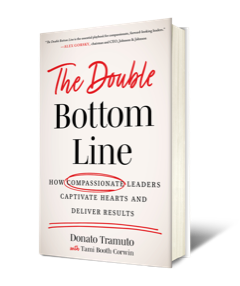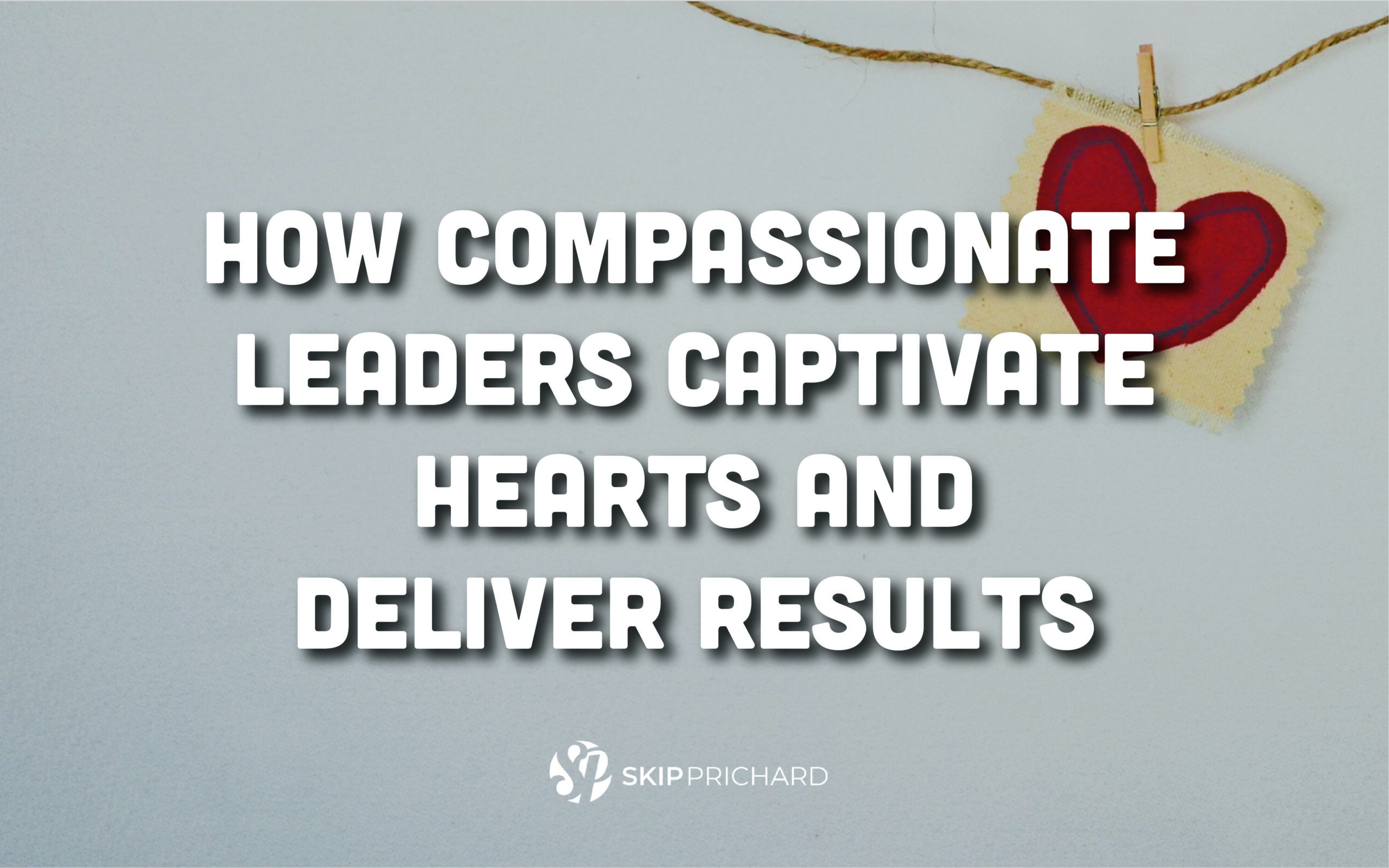Unprecedented and Constant Change
Leaders today are facing unprecedented uncertainty and constant change. A pandemic, fast-changing technologies, global competition, the Great Resignation, and shifting leadership demands.
The Double Bottom Line shares proven strategies to both put people first and deliver results. Donato J. Tramuto argues that successful leaders practice compassionate leadership by showing numerous firsthand examples and profiling compassionate leaders. Donato is a global health activist and the former CEO of Tivity Health. His business experience is extensive from launching startups to leading public company turnarounds.
I recently spoke with him about his research and work.
Why do we need to rethink leadership?
Many factors have combined to make adopting a new model of leadership essential for sustainable success. One major factor is a growing demographic gap between leaders and workers that is driving this demand for a new kind of leadership model. The average age of CEO’s in the United States is fifty-nine. Among Fortune 500 CEO’s, about 86% of them are white males many of whom learned under leaders who had a traditional top down, command and control style that prioritized profit over people. Today’s workforce is radically different from those who lead them. Half of workers are under 40 and non-white. These workers have different experiences, perspectives, and priorities than their leaders. Recent societal issues like Covid-19, social unrest, income inequality, racial injustice and climate change have amplified these priorities, taking them from important to imperative. Layer on top of all these factors the fact that we are now in an age of accelerating automation and artificial intelligence, which counterintuitively has made soft skills like collaboration, communication, and creativity even more necessary for success. Compassionate leadership informs and inspires all of these.
Today’s workers are looking for leaders who put people first, who respectfully acknowledge and support their wellness, their goals, their lives outside of work, their financial needs and their differences. They’re looking for conscious compassionate leaders. It’s not surprising that only 1/3 of employees are engaged at work. Lower engagement leads to decreased innovation, lower productivity, higher turnover, all of which eventually damage the bottom line. If the effect of this dismal engagement rate hasn’t made leaders wake up to the need for a new model of leadership, the great resignation and the current catastrophic lack of workers should.
While the need is great for a new leadership model, there is much to be optimistic about. People and profit not only can coexist, but in fact, putting people first drives profit. These two metrics lifting each other is what I call a very healthy Double Bottom Line. Companies who practice this form of leadership effectively have great success across metrics – look at companies like Salesforce, Microsoft or Paypal who have been led by CEO’s who celebrate compassionate leadership– they deliver better business while their people and their communities and the world beyond them benefit. More good news: This model is something that can be taught and learned. And, once compassion is embraced, it benefits the leader as much as it benefits their people.
Hence, why we believe Compassionate Leadership is the new model.
What are some of the myths surrounding compassionate leadership?
Myth 1: Being compassionate is the same as being nice.
Not true! I can be nice to an employee who comes to me with a problem yet not do anything to embrace actionable steps to address the problem. Being nice in that case is not only not enough, but it can also lead to disappointment or lack of trust on the part of the employee — definitely not compassionate.
Myth 2: Compassionate Leadership is a weak form of leadership.
This is one of the biggest misconceptions I’ve seen. In fact, 67% of senior leaders in our workplace survey said that compassionate leadership is often viewed as weak. This has obviously been a roadblock for many leaders. They fear that being compassionate might lead their workers or colleagues to have less respect for them, or worse, to push them around or walk all over them. This happens when compassion is misunderstood or misapplied. True compassion combines empathy with taking action to improve the situation. The element of action is where you find toughness, courage and strength. An example: If a leader has an employee who is toxic to their culture, their other employees are coming to that leader telling them that the employee is hurting their team. Clearly some tough action needs to be taken. A compassionate leader in that situation shows compassion to his employees by putting a stop to the toxic actions of one. But even if that leader lets the toxic employee go, they can do it compassionately showing empathy for whatever led to their behavior and perhaps even offering some assistance in a transition. In the long run, that employee having to live with the consequences of losing that job might even learn from it and end up thriving somewhere else because of the action that leader took. This type of compassionate action takes courage and strength.
Many people talk about empathetic leadership, but you say it isn’t enough. Tell us more.
It simply is not enough to show empathy. To have impact, you need to take it to the next step which is action. Too many leaders will say, “I feel your pain” and then move onward. The compassionate leader will take the time to understand the other person’s issues/challenges/problems, and together they will engage in a conversation to develop action steps that lead to impactful solutions. Sometimes this will be done alone. Regardless, courage is an important ingredient in compassionate leadership because sometimes you may have to go down the road less traveled and make decisions that demonstrate your commitment to fully close the loop – empathy + action = impact.
What are some of the key ways leaders can build trust?
Be true to your words around listening and then follow through with action. We too often engage in one-way ‘versations‘ and not conversations, and in doing so, we miss the important aspects of what is really happening. Leaders need to be the chief obstacle officers and view every conversation as a two-way communication. Additionally, having an open-door policy no longer cuts the leadership mustard. To gain trust you must move from an open-door policy to a proactive walking to a person’s desk and asking the question to which you are not afraid to receive the answer: “Tell me about your day and what you are experiencing at this moment”. Another important variable to gaining trust is to communicate – communicate both the good and the not so good news. Today’s employee population has lived through more crisis situations over the last 20 years than perhaps the older generation has in a lifetime. They can handle the good and the bad, and you will lose trust if you do not embrace this concept of tell me what you know.
Compassionate leadership is not only about caring, but also includes being tough when necessary. How do leaders get the balance right between tenderness and toughness?
 In our model, tenacity comes last in our 3T approach (Tenderness, Trust, and Tenacity) and there is no divisional calculation to each of the 3Ts. Each of them requires 100% in the evolution around compassionate leadership. Tenderness requires you to devote 100% of your energy (and forget about trust at that moment) to truly showing the employee you care about them. This will not happen in just one occasion; it may take weeks and months. However, you will know when you move to the 2nd T – Trust – when the person feels comfortable enough with you to share their story – concerns – passions, etc. – Once you have the trust, the relationship moves to a new level whereby you can be tenacious when the situation calls for it albeit you will find that because of the trust you have gained, conversations have more of a tenderness flavor. This tenderness or caring coupled with respect and trust allow for more effective listening and sharing, even when dealing with tough conversations or situations.
In our model, tenacity comes last in our 3T approach (Tenderness, Trust, and Tenacity) and there is no divisional calculation to each of the 3Ts. Each of them requires 100% in the evolution around compassionate leadership. Tenderness requires you to devote 100% of your energy (and forget about trust at that moment) to truly showing the employee you care about them. This will not happen in just one occasion; it may take weeks and months. However, you will know when you move to the 2nd T – Trust – when the person feels comfortable enough with you to share their story – concerns – passions, etc. – Once you have the trust, the relationship moves to a new level whereby you can be tenacious when the situation calls for it albeit you will find that because of the trust you have gained, conversations have more of a tenderness flavor. This tenderness or caring coupled with respect and trust allow for more effective listening and sharing, even when dealing with tough conversations or situations.
Let’s talk about the future workforce. You share a perspective about Gen Z which was intriguing. What are a few things we need to know about this generation?
Like generations before them, they also have a need for belonging, and there is less of an importance placed on titles and prestige. This is an important take away given that the average C-Suite executive in corporate America is in their 50s with a propensity toward the opposite sense of belonging: title and prestige. Hence, today’s leaders have to look beyond their own biases and accept a whole new venue of what “sense of belonging” means for the Gen Z if you are to be successful increasing their motivation at work. For example, Gen Z don’t simply want to buy a brand, they want to join in and be part of that community. I was prompted to write this book by my many years working as a healthcare executive to address loneliness, and for the longest time I had a bias that loneliness was simply associated to the senior population. I was wrong – on paper Gen Z should be the most connected generation since they were born after the digital revolution. But in reality, this is not true when it comes to relationships. There is a significant loss of community in full play which has led to a growing sense of isolation exacerbated by the many social issues they are facing. They are longing to belong, and this should be an important message to leaders.
Speak to the newly minted manager who is about to start the leadership journey. What advice would you provide?
Throw out the old playbook. For example, when I started my leadership journey, I was taught to focus on culture first. Many advisors would tell me, “Culture eats strategy for lunch!” Wrong! Trust now eats culture and strategy for lunch! Take the time – and it will take time – to gain the trust from your employee population and then you can focus on the culture and strategy. Focusing on trust is part of the people-first approach to leadership. Leadership isn’t about you, what you know or what you can accomplish on your own. It’s about getting the most from your people, and this only happens when you truly put them first.
For more information, see The Double Bottom Line.
Image Credit: Debby Hudson.

